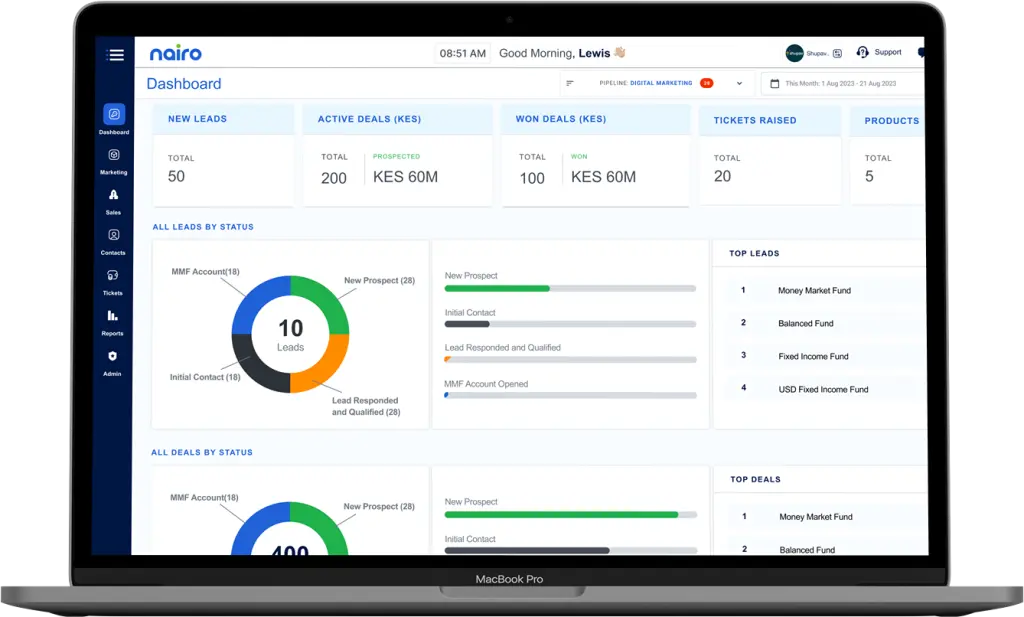For many small businesses, a spreadsheet is the first “CRM.” It’s easy to see why – tools like Excel or Google Sheets are free (or already available), familiar, and seem to do the job when you have a handful of customers. In the early days of a business, tracking sales in a single sheet may feel completely sufficient.
But as your business grows, the cracks in the spreadsheet approach start to show. What once was simple becomes cumbersome and error-prone. Yet, some SMEs cling to their spreadsheets out of habit or the desire to save costs, not realizing how it might be hurting them.
It’s time to confront the truth: while spreadsheets are great for certain tasks, they simply can’t replace a proper CRM when it comes to managing customer relationships and driving sales growth. Especially in the African business context – where teams may be spread out, working on the go, and handling lots of informal client data – relying solely on spreadsheets can hold your business back.
The Appeal of Spreadsheets (Why We Fall in Love with Excel)
Let’s acknowledge why so many small business owners start with spreadsheets:
- They’re Free (or Already Owned): You likely already have Excel as part of MS Office or can use Google Sheets for free. There’s no additional expense, which is attractive when budgets are tight.
- No Learning Curve: Everyone in the office knows how to enter data in a table. No need for training or new software setups. In contrast, adopting a CRM sounds like a project – who has time for that when you’re hustling to get sales?
- Flexible (Initially): A spreadsheet is a blank canvas. You can make your own columns, use colors to flag hot leads, add a new sheet for each month or each salesperson. It feels very malleable to whatever your immediate needs are.
- Control: You’re not dependent on an external system. Your data lives in a file you can copy, email, or tweak at will. There’s a sense of control and ownership, which is comforting.
In the very beginning, these benefits make a lot of sense. A two-person startup can list all prospects in a single Google Sheet tab and call it a day. The problems start when you scale beyond that…
The Hidden Truth: Why Spreadsheets Fall Short
What many entrepreneurs don’t realize at first is that the spreadsheet approach doesn’t scale. Here are harsh realities that emerge as your customer list and team grow:
- Data Gets Messy and Unreliable: With multiple people handling a spreadsheet, things can go wrong. One person sorts the sheet by name, forgetting to include all columns in the sort – now your rows are jumbled (a nightmare scenario where phone numbers don’t match the right names!). Or someone accidentally deletes a row or column during editing. Unless you have strong version control, you might not even catch these errors until damage is done. Human error can seriously corrupt a spreadsheet over time.
- No Single Source of Truth: If your team can’t simultaneously work on a spreadsheet (or don’t have reliable internet to use an online sheet), people end up making their own copies. You’ll find salespeople maintaining separate Excel files for their leads. Soon you have multiple versions floating around – no one has the full picture, and combining data later is a huge pain. A CRM, on the other hand, provides a single shared database everyone updates, so it’s always up-to-date and complete.
- Lack of Reminders & Follow-up Management: Spreadsheets don’t remind you to call back that hot lead from last week. They won’t ping you when it’s time to renew a big client’s contract. People try workarounds – like adding reminder dates in a column and coloring them red if overdue – but it’s all manual. Important tasks inevitably slip through the cracks. CRMs excel at this: they automatically notify you of follow-ups, allow you to set tasks and get alerts, ensuring you never forget a client interaction.
- No Automation: Every action in a spreadsheet is manual. If a new inquiry comes from your website, someone has to key it into the sheet. If you want to send a marketing email to all your prospects, you manually copy emails (risking copy-paste errors or missing entries). A CRM can automate these – web form submissions go straight into the system, you can send bulk emails or texts with a few clicks, and interactions can even be logged automatically. By sticking to spreadsheets, you spend a lot of extra time on administrative tasks that a CRM would handle in the background.
- Poor Analytics and Reporting: Let’s say you want to know your conversion rate from lead to sale for Q1 versus Q2, or which product is most popular among your repeat customers. In a spreadsheet, you’re looking at hours of manual tallying, writing complex formulas or creating pivot tables (if you’re Excel-savvy) – and every time you want an updated figure, you do it all over again. Most CRMs generate these metrics instantly with built-in reports and charts. Without those insights, you’re flying blind or spending energy on analysis instead of acting on the insights.
- Collaboration Headaches: In today’s world, sales is often a team sport. Maybe one person generates leads, another closes deals, another handles after-sales service. Spreadsheets are not built for multi-user collaboration or tracking interactions. Have you ever tried to figure out who last spoke to a client and what was said, by looking at a row in Excel? You can’t, unless someone diligently types a novel in a notes column. In a CRM, there’s a timeline of interactions – calls, emails, meetings – so anyone can quickly catch up on the history. This kind of collaborative visibility is nearly impossible with just a spreadsheet.
- Security and Professionalism: As your customer list grows, it becomes a valuable asset. Spreadsheets lack robust access controls (maybe you lock it with a password, but then everyone uses the same password) and they can be easily copied or sent to outsiders. If a salesperson leaves the company, they could take the Excel file with them, and you’d have no easy way to prove data theft. CRMs offer user-based permissions and audit logs, helping secure your customer data. Also, think about customer perception: using a CRM often comes with features like emailing quotes or invoices directly, tracking support tickets, etc. Sticking to primitive methods can sometimes show through to clients (like inconsistent follow-ups or “oops, I forgot we already talked” moments), whereas a CRM-backed operation comes off as more professional and reliable.
The truth is, what started as the easy solution can become a hidden obstacle to your growth. Many businesses realize this only after they encounter a serious mishap – like a deal lost because someone forgot to follow up, or an embarrassing moment of duplicate sales efforts because two team members weren’t on the same page.
When Spreadsheets Start to Strangle Growth
There’s often a tipping point. Perhaps you hit 100 customers, or your sales team grows beyond 2-3 people. That’s when the spreadsheet system often breaks down. Simple tasks take too long, everyone’s frustrated, and you might notice sales opportunities being missed.
Here’s a real scenario that happens more often than you’d think: A growing distribution company had been managing clients in Google Sheets. Two sales reps ended up calling the same big prospective client on the same day, unknowingly overlapping efforts – one using an outdated copy of the contact list. It made the company look disorganized and internally, both reps were upset at the mix-up. This was a wake-up call that they needed a single system of record.
Another example: a services firm kept track of project proposals in Excel. They realized they’d forgotten to follow up on a proposal for a huge potential contract, but only after the client awarded it to a competitor. The reminder date was in the spreadsheet, but with dozens of rows, nobody saw it. Opportunities like these slipping away are costly lessons.
The key insight is: if you aspire to grow, you will outgrow spreadsheets for CRM. In fact, data backs this up – the vast majority of businesses beyond the tiniest size are using CRM software. According to industry statistics, about 91% of companies with over 11 employees use a CRM system, whereas only 50% of those with 10 or fewer employees do. This shows that once a business hits a certain scale, a CRM stops being a luxury and becomes a necessity.
Another report found that about 65% of small-and-medium businesses adopt a CRM within their first 5 years of operation. Why? Because those that don’t often struggle with organization and efficiency as they expand. It’s telling that so many peers make the switch – it’s a competitive disadvantage to be the one still stuck on manual methods when others are turbocharging their sales process with automation and insights.
Embracing CRM: It’s Easier (and More Affordable) Than You Think
We get it – change is hard. You might worry that introducing a CRM will bring costs, complexity, or disrupt your current workflow. But modern CRMs, especially ones like NairoCRM designed for SMEs, are breaking those barriers:
- Affordable Options: Not all CRMs are pricey enterprise systems. There are solutions tailored for small businesses with freemium models or low-cost plans. Our goal with NairoCRM is to offer an entry point that’s as budget-friendly as possible, so cost isn’t a blocker. Consider what a lost sale or an inefficient process is costing you – that’s likely far more than a reasonable CRM subscription.
- User-Friendly Design: Gone are the days when using a CRM felt like using an ERP system from the 90s. NairoCRM, for instance, is being crafted to be intuitive (even fun) to use. If you can handle basic computer tasks, you can handle updating a deal status or adding a note in our CRM. Plus, we offer localized training materials to help teams transition smoothly.
- Quick Wins: The beauty of switching to a CRM is that you often see immediate improvements. Many businesses are amazed at how quickly they spot opportunities once their data is organized and accessible. Imagine opening your dashboard and seeing “10 leads with no follow-up in 2 weeks” – and being able to act on that at once. Or getting an automatic alert: “Client X hasn’t been contacted in 30 days” – prompting you to check in and perhaps catch a sale before it fizzles. These quick wins translate to revenue and saved relationships, which spreadsheets would have silently let drop.
- Scalability and Peace of Mind: With a CRM, you’re building an engine for customer management that can run even as you add hundreds of customers. You won’t be constantly reinventing your tracking method – the CRM grows with you. This means as you hire new sales reps, onboarding them is as simple as adding a new user to the system, rather than handing them a messy workbook and hoping they understand it. That peace of mind is priceless; you can focus on strategy and growth, not paperwork.
The Bottom Line: Level Up from Cells to CRM
The truth African SMEs must hear is that sticking with spreadsheets for managing sales and customers is like trying to compete in a race driving a makeshift cart while others have motorbikes. Yes, your cart works – it’ll roll forward – but it’s not going to win when the race heats up.
Spreadsheets have their place (finance teams love them for good reason, and they’re great for certain analyses), but for CRM, you need a purpose-built solution to truly excel (no pun intended). It’s about equipping your business with the right tools at the right time.
If you’re reading this and feeling that your organization might be at that tipping point, consider this a friendly nudge. The sooner you adopt a proper CRM, the sooner you’ll wonder how you ever managed with that tangle of spreadsheets.
Remember, CRM isn’t about complexity – it’s about clarity. It’s about making sure no customer is forgotten and every opportunity is maximized. Isn’t that what you want as a growing business?
Ready to leave the spreadsheet shuffle behind? NairoCRM is here to make the transition smooth and rewarding. We specifically encourage businesses in Africa to take that step into modern customer management with confidence. Join the NairoCRM waitlist today and be part of the movement towards smarter, simpler, and more effective sales processes. Early adopters will gain access to our platform soon, along with exclusive benefits like tailored onboarding help. Don’t let old habits stunt your growth – embrace the tools that can propel you forward. Sign up now and see the difference when you trade cells for a CRM that tells you exactly what you need to do to grow your business.





